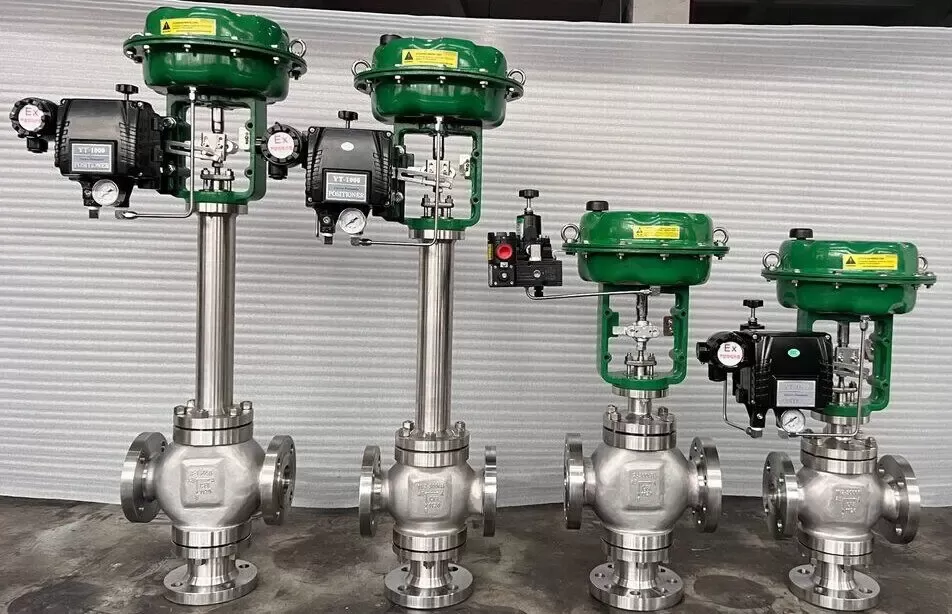Notifications

6 minutes, 20 seconds
-7 Views 0 Comments 0 Likes 0 Reviews

In industries ranging from power generation and chemical processing to HVAC and water treatment, precise fluid control is essential. One versatile and widely used solution in complex piping systems is the 3-way globe control valve. Designed for both mixing and diverting fluid flows, this valve offers reliable performance, excellent throttling capability, and simplified system architecture.
This article explains the working principles, configurations, operation methods, advantages, and applications of 3-way globe control valves—along with key considerations for selection and maintenance.
A 3-way globe control valve is a linear motion valve with three ports that can either mix two incoming fluid streams into one or divert one stream into two different paths. Its globe-shaped body houses a movable plug or disc that regulates flow through a seat, controlled by an actuator (manual, pneumatic, electric, or hydraulic).
The three ports are typically labeled A, B, and AB (or M). Based on internal design and actuator control, the valve can operate in mixing, diverting, or universal configurations.
Function: Combines two fluid streams (inlets A and B) into one outlet (AB).
How It Works: The plug adjusts flow from each inlet to control the mixing ratio.
Applications:
HVAC systems (hot/cold water mixing)
Process temperature regulation
Chemical blending
Function: Directs one fluid stream (inlet A) into two outlets (B and AB).
How It Works: The plug shifts to route flow to one of the two outlets.
Applications:
Alternating flow paths in processing systems
Switching cooling or lubrication circuits
Maintenance line routing
Function: Supports both mixing and diverting.
How It Works: Advanced plug design and control logic allow two ports to act as inlets and the third as an outlet.
Applications:
Complex HVAC loops
Chemical dilution systems
Reversible flow applications
The valve operates by moving a plug or disc via a stem, modulating flow through the internal seat. This movement is controlled by an actuator, which receives input from a manual handle or automated control system.
Mixing Mode: Two inlets → single outlet. Plug modulates ratio of incoming flows.
Diverting Mode: One inlet → two outlets. Plug directs flow to desired outlet.
Universal Mode: Two variable ports as inlets/outlets with programmable control.
Manual:
Handwheel-operated
Used for simple, low-frequency adjustments
Pneumatic:
Air-operated actuators
Fast and reliable for industrial automation
Electric:
Motor-driven control
Ideal for remote or digital control systems
Hydraulic:
Used in high-force, high-pressure environments
Each actuator can integrate with positioners and controllers for real-time automation.
Versatility: One valve performs the role of two, reducing system complexity.
Precision: Globe design enables fine flow modulation.
Space-Saving: Compact configuration simplifies piping.
Durability: Handles high pressure and temperature conditions.
Serviceability: Modular design allows easy inspection and maintenance.
| Industry | Use Case |
|---|---|
| HVAC | Mixing hot/cold water or redirecting flow between zones |
| Chemical Processing | Blending reactants, switching reactor paths |
| Power Generation | Managing boiler feedwater, steam, and condensate |
| Food & Beverage | Batch processing, CIP (Clean-in-Place) systems |
| Pharmaceuticals | Dosing and sterile fluid control |
| Oil & Gas | Flow diversion in blending or separation systems |
To ensure optimal performance, consider the following during valve selection:
Body Material: Stainless steel (CF8M), carbon steel, bronze—selected based on fluid compatibility and corrosion resistance.
Plug and Seat Design: V-port, contoured, or linear trim shapes for desired control accuracy.
Flow Coefficient (Cv): Ensure proper sizing for flow capacity and pressure drop.
Temperature/Pressure Ratings: Must meet system requirements.
Actuator and Controls: Choose based on automation needs and communication protocols (e.g., 4–20 mA, digital bus).
Routine maintenance ensures longevity and consistent performance:
Inspect for leaks, corrosion, or wear
Lubricate moving components as needed
Clean internal flow paths, especially in mixing applications
Calibrate actuators and positioners periodically
Common issues include:
Plug/stem wear
Actuator misalignment
Clogging from deposits or debris
Preventive maintenance minimizes downtime and costly failures.
The 3-way globe control valve is a powerful solution for systems requiring precise fluid mixing or diversion. With its flexible configuration, reliable throttling characteristics, and integration-friendly design, it plays a crucial role in modern process control systems.
From balancing temperatures in HVAC systems to managing complex chemical flows, these valves streamline operations, reduce equipment needs, and improve overall control. With proper material selection, automation, and maintenance, a 3-way globe valve can significantly enhance both efficiency and operational flexibility across a range of industries.Know more about Google SEO Directory

